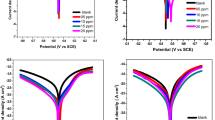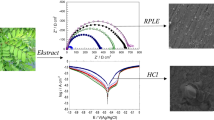Abstract
The influences of Polycarpaea corymbosa (PC) and Desmodium triflorum (DT) leaf extracts on the corrosion behavior of mild steel (MS) in 1.0 M HCl was investigated by weight loss, potentiodynamic polarization and electrochemical impedance spectroscopy (EIS) measurements. The effect of temperature on the corrosion behavior of MS in 1.0 M HCl with the addition of plant extracts was studied in the temperature range of 300 K–320 ± 1 K. The results revealed that PC and DT were excellent green inhibitors and the inhibition efficiencies obtained from weight loss and electrochemical experiments were in good agreement. Inhibition efficiencies up to 91.78 % for PC and 92.99 % for DT were obtained. Potentiodynamic polarization studies revealed that both the inhibitors behaved as mixed-type inhibitors. Adsorption behavior of these green inhibitors on the MS surface was found to obey the Langmuir adsorption isotherm. The thermodynamic parameter values of free energy of adsorption (∆G ads) and enthalpy of adsorption (∆H ads) revealed that each inhibitor was adsorbed on the MS surface via both chemisorption and physisorption mechanisms. The adsorption mechanism of inhibition was supported by FT–IR, UV–Visible, WAXD and SEM–EDS.










Similar content being viewed by others
References
Oguzie EE (2005) Corrosion inhibition of mild steel in hydrochloric acid solution by methylene blue dye. Mater Lett 59:1076–1079
Quraishi MA, Ahamad I, Singh AK (2008) N-(Piperidinomethyl)-3-[(pyridylidene) amino] isatin: a new and effective acid corrosion inhibitor for mild steel. Mater Chem Phys 112:1035–1042
Bentiss F, Bouanis M, Mernari B, Traisnel M, Vezin H, Lagrenee M (2007) Understanding the adsorption of 4H–1,2,4-triazole derivatives on mild steel surface in molar hydrochloric acid. Appl Surf Sci 253:3696–3701
Keles H, Keles M, Dehri I, Serindag O (2008) The inhibitive effect of 6-amino-m-cresol and its Schiff base on the corrosion of mild steel in 0.5 M HCI medium. Mater Chem Phys 112:173–179
Negm NA, Zaki MF (2009) Synthesis and evaluation of 4-diethylamino benzaldehyde Schiff base cationic amphiphiles as corrosion inhibitors for carbon steel in different acidic media. J Surf Deterg 12:321–3296
Azambuja DS, Martini EAA, Muller L (2003) Corrosion behavior of iron and AISI 304 stainless steel in tungstate aqueous solutions containing chloride. J Braz Chem Soc 14:570–576
Negm NA, El-Farragry AF, Abdelrahman NR (2011) New Schiff base cationic surfactants: surface and thermodynamic properties and applicability in bacterial growth and metal corrosion prevention. J Surf Deterg 14:505–514
Olorunniwo OE, Umoru LE, Bamigboye OR (2006) Sodium chromate and diethylene amine as corrosion inhibitors for mild steel in cassava fluid. J Appl sci 6(4):878–882
Negm NA, Zaki MF (2008) Corrosion inhibition efficiency of nonionic Schiff base amphiphiles of p-aminobenzoic acid for aluminum in 4 N HCl. Colloids Surf A 322:97–1029
Aiad IA, Negm NA (2009) Some Schiff base surfactants as steel corrosion inhibitors. J Surf Deterg 12:313–319
Aiad IA, Negm NA (2009) Some corrosion inhibitors based on Schiff base surfactants for mild steel equipments. J Dispers Sci Technol 30:1142–1147
Etre AYE, Abdullah M, Tantawy ZEE (2005) Corrosion inhibition of some metals using Lawsonia extract. Corros Sci 47:385–395
Satapathy AK, Gunasekaran G, Sahoo SC, Amit K, Rodrigues PV (2009) Corrosion inhibition by Justicia gendarussa plant extract in hydrochloric acid solution. Corros Sci 51:2848–2856
Ostovari A, Hoseinieh SM, Peikari M, Shadizadeh SR, Hashemi SJ (2009) Corrosion inhibition of mild steel in 1.0 M HCl solution by henna extract: a comparative study of the inhibition by henna and its constituents (Lawsone, Gallic acid, á-d-Glucose and Tannic acid). Corros Sci 51:1935–1949
Oguzie EE (2008) Evaluation of the inhibitive effect of some plant extracts on the acid corrosion of mild steel. Corros Sci 50:2993–2998
Okafor PC, Ikpi ME, Uwaha IE, Ebenso EE, Ekpe UJ, Umoren SA (2008) Inhibitory action of Phyllanthus amarus extracts on the corrosion of mild steel in acidic media. Corros Sci 50:2310–2317
Abdel-Gaber AM, Abd-El-Nabey BA, Sidahmed IM, El-Zayady AM, Saadawy M (2006) Inhibitive action of some plant extracts on the corrosion of steel in acidic media. Corros Sci 48:2765–2779
Chauhan LR, Gunasekaran G (2007) Corrosion inhibition of mild steel by plant extract in dilute HCl medium. Corros Sci 49:1143–1161
Bouyanzer A, Hammouti B, Majidi L (2006) Pennyroyal oil from Mentha pulegium as corrosion inhibitor for steel in 1.0 M HCl. Mater Lett 60:2840–2843
Abdel-Gaber AM, Abd-El-Nabey BA, Saadawy M (2009) The role of acid anion on the inhibition of the acidic corrosion of steel by lupine extract. Corros Sci 51:1038–1042
Khare CP (2007) Indian medicinal plants: an illustrated dictionary. Springer, Berlin
Chang YX (2000) Taiwan native medicinal plants. Committee on Chinese medicine and pharmacy. Dept. Health, Executive Yuan, Taipei, p 158 (In Chinese)
Arthur HR, Cheung TH (1960) A phytochemical survey of the Hong Kong medicinal plants. J Pharm Pharmacol 12(1):567–570
Harborne JB (1973) Phytochemical methods. Chapman and Hall, London, pp 49–188
Sreenivasan KK, Sankarasubramanian S (1984) Chemical investigation of Desmodium triflorum. J Health Sci 10(2):156–158
Adinarayana D, Syamasundar KV (1982) Occurrence of a rare diholosylflavone 2-O-glucosylvitexin in Desmodium triflorum. Corros Sci 51(19):936–937
Jayaweera DMA (2006) Medicinal plants (Indigenous and exotic) used in Ceylon, 5th edn. National Science Foundation, Srilanka
Ghosal S, Srivastava RS, Banerjee PK, Dutta SK (1971) Alkaloids of Desmodium triflorum. Phytochemistry 10:3312–3313
Kawshik KC, Achinto S, Sitesh CB, Joydeb KK (2005) Analgesic and anti-inflammatory activities of Desmodium triflorum DC. J Biol Sci 5:581–583
Lai SC, Ho YL, Huang SC, Huang TH, Lai ZR, Wu CR, Lian KY, Chang YS (2010) Antioxidant and anti –proliferative activities of Desmodium triflorum (L.) DC. Am J Chin Med 38:329–342
Sofowara A (1993) Medicinal plants and traditional medicine in Africa. Spectrum Books, Ibadan 289
Kesavan D, Muthu Tamizh M, Sulochana N, Karvembu R (2012) 2-[(E)-{(1S,2R)-1-Hydroxy-1-phenylpropan-2-ylimino}methyl]phenol for Inhibition of Acid Corrosion of Mild Steel. J Surfact Deterg. doi:10.1007/s11743-012-1370-z on line first, may 2012
Gopiraman M, Selvakumaran N, Kesavan D, Kim IS, Karvembu R (2012) Chemical and physical interactions of 1-benzoyl-3,3-disubstituted thiourea derivatives on mild steel surface: corrosion inhibition in acidic media. Ind Eng Chem Res 51:7910–7922
Gopiraman M, Selvakumaran N, Kesavan D, Karvembu R (2012) Adsorption and corrosion inhibition behaviour of N-(phenylcarbamothioyl) benzamide on mild steel in acidic medium. Prog Org Coat 73:104–111
Gopiraman M, Sathya C, Vivekananthan S, Kesavan D, Sulochana N (2012) Influence of 2,3-dihydroxyflavanone on corrosion inhibition of mild steel in acidic medium. J Mater Eng Perform 16:240–246
Negm NA, Morsy SMI, Said MM (2005) Corrosion inhibition of some novel hydrazone derivatives. J Surf Deterg 8:95–98
Solmaz R, Kardas G, Culha M, Yazici B, Erbil M (2008) Investigation of adsorption and inhibitive effect of 2-mercaptothiazoline on corrosion of mild steel in hydrochloric acid media. Electrochim Acta 53:5941–5952
Migahed MA, Nassar IF (2008) Corrosion inhibition of Tubing steel during acidization of oil and gas wells. Electrochim Acta 53:2877–2882
Bentiss F, Lagrenee M, Traisnel M, Hornez JC (1999) The corrosion inhibition of mild steel in acidic media by a new triazole derivative. Corros Sci 41:789–803
Bentiss F, Lebrini M, Lagrenee M (2005) Thermodynamic characterization of metal dissolution and inhibitor adsorption processes in mild steel/2,5-bis(n-thienyl)-1,3,4-thiadiazoles/hydrochloric acid system. Corros Sci 47:2915–2931
Negm NA, Al Sabagh AM, Migahed MA, Abdel Bary HM, El Din HM (2010) Effectiveness of some diquaternary ammonium surfactants as corrosion inhibitors for carbon steel in 0.5 M HCl solution. Corros Sci 52:2122–2132
Behpour M, Ghoreishi SM, Soltani N, Salavati-Niasari M, Hamadanian M, A Gandomi (2008) Electrochemical and theoretical investigation on the corrosion inhibition of mild steel by thiosalicylaldehyde derivatives in hydrochloric acid solution. Corros Sci 50:2172–2181
Negm NA, Elkholy YM, Zahran MK, Tawfik SM (2010) Corrosion inhibition efficiency and surface activity of benzothiazol-3-ium cationic Schiff base derivatives in hydrochloric acid. Corros Sci 52:3523–3536
Hackerman N, Snavely E, Payne JS (1966) Effects of anions on corrosion inhibition by organic compounds. J Electrochem Soc 113:677–682
Quraishi MA, Ansari FA, Jamal D (2002) Thiourea derivatives as corrosion inhibitors for mild steel in formic acid. Mater Chem Phys 77:687–690
Tan YJ, Bailey S, Kinsellal B (1996) An investigation of the formation and destruction of corrosion inhibitor films using electrochemical impedance spectroscopy (EIS). Corros Sci 38:1545–1549
Singh AK, Quraishi MA (2010) Effect of Cefazolin on the corrosion of mild steel in HCl solution. Corros Sci 52:152–160
Taqui MM, Shukla RS (1992) Kinetic and spectroscopic study of the formation of an intermediate ruthenium (III) ascorbate complex in the oxidation of L-ascorbic acid. Polyhedron 10:2711–2721
Negm NA, Mohammed AS (2004) Surface and thermodynamic properties of diquaternary bola-form amphiphiles containing an aromatic spacer. J Surf Deterg 7:23–30
Saliyan R, Adhikari AV (2009) N'-[4-diethylamino)benzylidine]-3-{[8-(trifluoromethyl)quinolin-4-yl]thio}propano hydrazide) as an effective inhibitor of mild steel corrosion in acid media. Mater Chem Phys 115:618–622
Abboud Y, Abourriche A, Saffaj T, Berrada M, Charrouf M, Bennamara A, Himidi N, Hannache H (2007) 2,3-Quinoxalinedione as a novel corrosion inhibitor for mild steel in 1 M HCl. Mater Chem Phys 105:1–5
Quraishi MA, Wajid Khan MA, Ajmal M, Muralidharan S, Venkatakrislina Iyer S (1996) Influence of substituted benzothiazoles on corrosion in acid solution. J Appl Electrochem 26:1253–1258
Rahim AA, Rocca E, Steinmetz J, Kassim MJ, Adnan R, Sani Ibrahim M (2007) Mangrove tannins and their flavonoid monomers as alternative steel corrosion inhibitors in acidic medium. Corros Sci 49(2):402–417
Gopiraman M, Sakunthala P, Kesavan D, Alexramani V, Kim IS, Sulochana N (2012) An investigation of mild carbon steel corrosion inhibition in hydrochloric acid medium by environment friendly green inhibitors. J Coat Technol Res 9:15–26
Gopiraman M, Sakunthala P, Kanmani R, Alex Ramani V, Sulochana N (2011) Inhibitive action of Clematis gouriana extract on the corrosion of mild steel in acidic medium. J Ionics 17:843–852
Author information
Authors and Affiliations
Corresponding authors
Electronic supplementary material
Below is the link to the electronic supplementary material.
About this article
Cite this article
Sakunthala, P., Vivekananthan, S.S., Gopiraman, M. et al. Spectroscopic Investigations of Physicochemical Interactions on Mild Steel in an Acidic Medium by Environmentally Friendly Green Inhibitors. J Surfact Deterg 16, 251–263 (2013). https://doi.org/10.1007/s11743-012-1405-5
Received:
Accepted:
Published:
Issue Date:
DOI: https://doi.org/10.1007/s11743-012-1405-5




